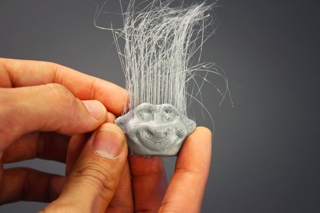Researchers at Carnegie Mellon University (CMU) have discovered a technique to produce 3D-printed hair-like fibers, bristles and strands using an inexpensive, commonly available 3D printer.
 CMU researchers have found a way to produce hair-like strands, like the ones on this 3-D printed troll, on a low-cost printer.
CMU researchers have found a way to produce hair-like strands, like the ones on this 3-D printed troll, on a low-cost printer.
The innovative technique has been inspired by the way in which gossamer plastic strands are formed or extruded when a hot glue gun is used.
"You just squirt a little bit of material and pull away," said Gierad Laput, a Ph.D. student in Carnegie Mellon's Human-Computer Interaction Institute (HCII). "It's a very simple idea, really."
The process does not require any special hardware. However, it is not fast as the plastic hair has to be produced strand by strand. For generating hair on an area of 10 mm2, it takes approximately 20 to 25 minutes. The hair that is produced can be cut, braided or curled. When the strands are dense and closely cropped they can be used to form a brush.
The team used a fused deposition modeling (FDM) printer that cost $300. In this low-cost printer, a plastic filament is passed through a heated nozzle. This nozzle extrudes the molten material (in the form of small, flattened strings) into specific patterns till the required 3D shape is obtained. The patterning is done in a layer-by-layer manner.
When a hair-like strand has to be produced, a molten plastic bit must be applied and the nozzle head must be pulled away rapidly. However, the print head does not have the speed to generate tapered strands, and it also cannot rise quickly.
The team found that both the print head and the print bed could move rapidly from side to side, but not upwards. When they applied the molten material and then moved the print head and the print bed from side to side, they were able to successfully create the desired hair-like strands.
Using this technique, the team added hair in different colors to various 3-D printed objects. These include a tail on a horse, long whiskers on a Gandalf-like wizard, and straight-up shock of hair on a troll head. Uniform root positions helped produce toothbrush bristles, while randomized root positions helped produce natural-looking hair.
In this project, the researchers used polylactide (PLA), which is a commonly available material. Laput stated that if acrylonitrile butadiene styrene (ABS) or another more sophisticated material was used, then hair with magnetic or other properties could be created.
The 3D-printed hair has been displayed at the Engadget Live event in Brooklyn, NY. The method to produce the 3D-printed hair is to be presented at the ACM User Interface Software and Technology Symposium (UIST 2015), by Laput, and Ph.D. student Xiang "Anthony" Chen, and Assistant Professor Chris Harrison of the HCII.
The David and Lucile Packard Foundation, Google, Yahoo! and Qualcomm supported this study.